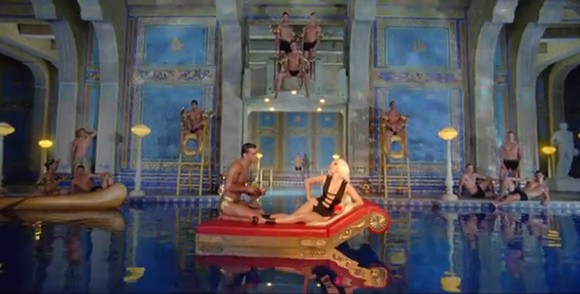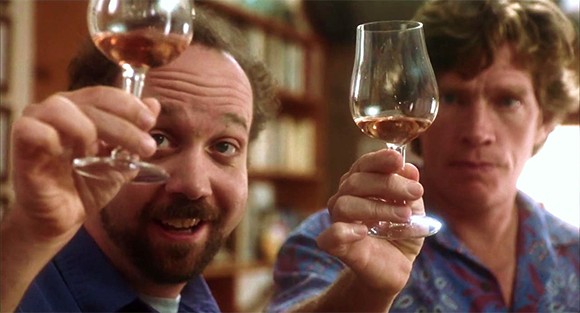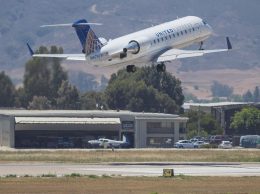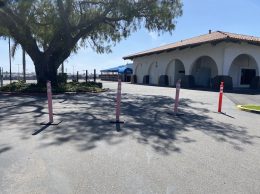
“The Bachelor” star Sean Lowe married Catherine Giudici at Santa Barbara’s Four Seasons Resort The Biltmore in a live TV broadcast. (Four Seasons media photo)
When Sean Lowe and bride-to-be Catherine tied the knot at the Four Seasons Resort in Montecito in January, millions tuned in to watch the “reality” TV stars exchange vows in a live broadcast. The behind-the-scenes decision to host the wedding in Santa Barbara, however, was anything but unscripted.
The first-ever live telecast of a “Bachelor” wedding was the result of a new film incentive program launched by Visit Santa Barbara, the South Coast’s tourism marketing group.
Film and television production reels in an estimated $60 million for the region each year, and the industry’s impact on the Tri-Counties is likely to rise as tourism groups in each of the three counties ramp up their outreach to Hollywood.
“It’s the kind of industry we’re happy to attract,” said Bruce Stenslie, president and CEO of the Economic Development Collaborative of Ventura County, the business group that operates the county’s film commission. “Filming is like tourism. People come into the region, they spend some time, they spend some money, and they spread the word through their network.”
Although Ventura County has only recently started collecting economic-impact data on the film industry, Stenslie estimated that productions generate close to $30 million annually for the county’s economy.
In Santa Barbara County, long a favorite filming destination, production had an estimated $26.5 million economic impact last year, according to Visit Santa Barbara. The organization recently launched a $50,000-a-year incentive program that extends filming rewards to unscripted shows such as reality TV and still photography, in addition to feature films and scripted TV.
In San Luis Obispo County, film production generated an estimated $4.1 million for the local economy last year. The effort to attract more production to the Central Coast is still in its infancy, said Visit San Luis Obispo County CEO Stacie Jacob, but is likely to become a larger part of the county’s tourism marketing effort.
As of January, more than 180 production leads had come through the SLO County’s Film Commission, a department of Visit San Luis Obispo County, for projects including independent feature films, television programs, commercials, catalog shoots, music videos and documentaries.
‘Heads in beds’
Each production impacts the regional economy beyond just the costs of film permitting. Production crews, often ranging from as few as five to more than 100 people, use services, stay in hotels, dine at area restaurants and purchase fuel.
In 2013, SLO County had 183 reported filming days, which translated to about 365 hotel room nights. “We definitely see it as a strategy that focuses on mid-week outreach — the idea that film crews will come in middle of the week, when we don’t have as many other visitors, and put heads in beds,” Jacob said.
SLO County has been a popular destination for car commercials in the past, she said, but when traditional tourism dropped off during the recession, the organization started to look at ways to better position itself as a filming destination. “We started at that time to build relationships with many scouts since we’re so close to L.A.,” she said. When the economy started to turn around, those efforts paid off: “In October 2012, the phone started ringing again,” she said. “Now we get a couple of calls a week.”
Lady Gaga

Pop star Lady Gaga worked with California’s state parks to secure permitting to shoot her latest music video at Cambria’s historic Hearst Castle.
A film commission acts as the liaison for production companies and location scouts, connecting them to sites, services and lodging and helping crews navigate the various permitting processes in each community.
The commissions also work to build awareness of their counties as filming destinations. “We have seen a lot of great response from the location scout familiarization tours we hosted the last two years,” Lauren Tognazzini, a SLO County Film Commission liaison, said in a statement. “It has increased awareness of our county as a filming destination, and we have been able to showcase the diverse geographic backdrops we can offer all within a short distance.”
While San Luis Obispo County can’t offer monetary filming incentives such as discounted fees or rebates, Jacob said it has tried to provide superior service. “We try to be a service liaison for production teams,” she said. “A lot of times we get a call looking for something specific, whether it be catering, makeup artists or editing booths. That’s what we’re here for. We could get a call on Monday about a crew wanting to shoot something on Friday,” she said. “We’re all very busy these days.”
Recent shoots on the Central Coast include Lady Gaga’s “G.U.Y.” music video, shot at the historic Hearst Castle in Cambria. The pop star’s video — which was permitted with California’s state parks and didn’t work with the film commission — has drawn close to 14 million views on YouTube.
In January, General Electric shot scenes for a commercial at San Luis Obispo County’s Santa Margarita Ranch. A crew of about 90 people traveled to the Central Coast and spent two days filming at the property, the ranch reported.
Other notable credits in SLO County include Animal Planet’s “Redwood Kings,” ABC’s “The Taste,” History Channel’s “Top Gear USA” and commercials for Mercedes, Porsche, Mazda, Maserati, Subaru, Jeep, Land Rover and Microsoft.
Cutting red tape
Ventura County has, under EDC-VC’s guidance, tried to show a friendlier face to the film industry in recent years.
In June 2013, EDC-VC created a film-industry liaison position and hired Karen Kelley, who previously worked for the city of Ventura and the Ventura Chamber of Commerce, for the new post. It also solicited $60,000 in funding for the film-liaison program. The funds came from the county and city governments and the private-sector.
Stenslie at EDC-VC said Ventura County had in years past earned a reputation as hostile to Hollywood, although movies ranging from “Bridesmaids” to “The Aviator” to “Little Miss Sunshine” have been filmed in the county.
Productions can have a negative impact when they make their temporary incursions into smaller communities. “Historically we haven’t done much with [the film commission],” Stenlsie said. “There’s been some ambivalence to the potential impact the industry can have.”
But during the recession, the group “started looking at filming as more of an opportunity and less of an intrusion,” he said. “Film scouts who in the past have not seen the county as film-friendly are now coming back and taking another look.”
Along with guiding film crews to resources, EDC-VC has tried to cut out red tape. “We’re looking to find ways to streamline, improve the efficiency and reduce the costs” of filming in Ventura County, Stenslie said.
The county has eased up on some regulations. It scrapped a requirement that the county also be named as in insured party when crews film on private property. “The county’s risk management took a look at that requirement and said it was a hassle and that it added extra cost to the production to name the county as insured,” Stenslie said.
He noted that Simi Valley, Westlake Village and parts of Moorpark and Thousand Oaks are in the so-called 30-mile zone around Hollywood that qualifies for lower production wages. Outside of that area, film crews under union contract must be paid per-diem and have overnight lodging provided to them.
EDC-VC estimates that over the four-month period between October 2013 and January 2014, production companies secured 247 permits to shoot 566 film days in Ventura County. The figure doesn’t include permits from state parks, some parks and recreation districts or school districts.
Annualized, the figures would come to 1,698 film days, generating about $30 million in economic impact.
‘Sideways’ impact

Paul Giamatti, left, and Thomas Haden Church portrayed two friends on a roadtrip through Santa Barbara County wine country in the 2004 Oscar-winning film “Sideways.”
Santa Barbara County has been a popular filming destination for about as long as it’s been a weekend hideaway for Hollywood’s rich and famous. But perhaps nothing put the region on the map quite like “Sideways,” the Oscar-winning film about two bachelors tasting wine and chasing women through the Santa Ynez Valley.
The 2004 film, starring Paul Giamatti, made Santa Barbara County an instant food and wine destination, with scenes shot at Firestone Vineyards, Fess Parker Winery, The Hitching Post II and Los Olivos Wine Merchant & Cafe, among numerous other locations. Giamatti’s character mused over the merits of pinot noir throughout the film, and the wine soon supplanted chardonnay as the Santa Ynez Valley’s signature varietal.
Other notable feature-film credits in Santa Barbara County include “Pirates of the Caribbean III,” “ It’s Complicated,” “Seabiscuit” and “Scarface.” The South Coast has also established itself as a reality-TV mecca, with shows from ABC’s “The Bachelor” and “Extreme Makeover” to TLC’s “ Trading Spaces” and “Say Yes to the Dress” filming shots in the area.
Film crews booked about 7,100 room nights in Santa Barbara County last year to shoot 172 productions over 423 production days, Visit Santa Barbara’s film commissioner, Geoff Alexander, said in an email to the Business Times.
Incentive program
Partly in response to the rising impact of reality TV, Visit Santa Barbara last year launched a new film incentive program. The initiative reimburses some permit and law enforcement fees — up to $2,500 per project — for qualifying productions that shoot during the slow tourism season between Sept. 30 and May 31. The incentive applies only to shoots that house crews in the “incentive zone,” currently the South Coast and Santa Ynez Valley, and the productions have to book a minimum number of room nights depending on the kind of project. For still photography and unscripted TV, for example, producers must book at least 50 room nights to qualify; for feature films, they have to book at least 200 room nights.
The rebate is the first of its kind in California, Visit Santa Barbara said. “The Santa Barbara County Media Production Incentive is the only incentive in the state to cover still photography, commercial and unscripted projects, thereby making it entirely unique,” Alexander said. “We decided to do this as these areas of production are traditionally overlooked but remain the most consistent big spenders in our area, so we want them to know that we welcome and value their business.”
ABC’s “The Bachelor” garnered national attention as millions tuned in to watch the TV nuptials. The wedding was filmed at The Biltmore in part due to the incentive program, and the event has in turned opened the door for a “follow-up project” that tourism leaders are still tight-lipped about.
“The Bachelor needed a beautiful destination and a willing partner — they found both in Santa Barbara with the Biltmore,” Alexander said. “The incentive reinforced their decision to come, and gave us the opportunity to pitch Santa Barbara for a major, follow-up project which will generate huge global PR for Santa Barbara. Unfortunately, at this point we are bound by confidentiality and can’t discuss the follow-up project until we are closer to air date, but we are extremely excited.”






 Print
Print Email
Email
















